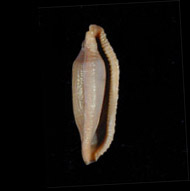|
< Previous family introduction |
|
|||||
 |
Family
Ovulidae
Egg Cowries |
|||||
|
The egg cowries are most
closely related to the true cowries, having in common an animal that
encloses the shell with retractable flaps of the mantle. They differ
from the true cowries by not having teeth on the inner edge of the
aperture, and by encompassing a variety of shapes; some are more or less
globular like the cowries, but others are drawn out at both ends into
long, slender shells. There are about 160-170 species world-wide, mostly
in the tropics.
All species of egg cowries live and feed on various types of corals: soft corals, sea fans, sea whips, sea pens and the horny gorgonian corals. In the tropics they and their hosts may occur intertidally, but in NSW they are restricted to the subtidal. Shell colour, size and proportions are affected by the host on which they live. Less than a dozen species are recorded from NSW, all having a tropical distribution with a southern limit of central or northern NSW. Specimens are uncommon to rare in NSW. They are occasionally found as beach shells, with only a few observations of living animals and their hosts having been reported. Family References:
Identification Notes: Ovulids differ from true cowries by not having teeth on the inner edge of the aperture. As in cowries, the outer lip folds inwards and thickens as the shell matures. The outer lip has an inner and outer edge - the inner edge is that towards the aperture. This is different to the inner lip of the aperture, which is the columellar side of the aperture. In addition to the illustrated species, the following tropical species occur rarely in the north of the state.
|